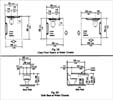
Mobility for all
Access to trip destination
by Tom Rickert
Trip destinations need to be accessible in order for frail elders and other persons with disabilities to have the mobility they need to lead independent lives. This means that there should be accessible pathways from transit stops to buildings and other facilities used by the public.
Such buildings include government offices, commercial buildings, railroad and bus terminals, schools, medical and recreational facilities, and houses of worship. Once the building is reached, the accessible pathway should continue through the door to destinations within the building, including auditoriums, sanctuaries of houses of worship, offices, bathrooms, public telephones, water fountains, and other public conveniences.
In general, the rules that apply for pedestrian paths to transit stops also apply for access to and within public buildings. The photo at upper left shows access from the street to the entrance of a public building in San Francisco, USA, while the diagram at upper right illustrates a ramp inside a church. In all cases, such ramps should not exceed one unit of rise for every twelve units of length.
The following standards are selected from the very detailed regulations of the Americans with Disabilities Act, which are used in the USA. They generally reflect current usage in North America and much of Europe:
Regarding paths of travel for wheelchair users and others with mobility impairments:
815 mm: minimum clear width for passages of a single wheelchair at a point (such as a doorway), with the passage itself 915 mm wide. 1525 mm: minimum width f or two wheelchairs to pass each other. 1525 mm: diameter of a clear space for a wheelchair user to make a 180-degree turn. 2030 mm: vertical clearance between a path of travel and an overhead obstruction (of special importance for blind persons or those who are partially sighted).
Ramps should be at an angle of not more than a 1:12 slope, that is, not more than 1 cm of rise for every 12 cm of length.
Landings at the top and bottom of a ramp should be level. A flat rest area should be provided on longer ramps after each rise of not more than 750 mm. The inclined surface of a ramp should have a contrasting color and a detectable non-slip surface. Ramps should be protected with handrails.
Ramps and corridors leading to buildings or inside of buildings should be free of protruding objects that can be a barrier to people who are blind or partially sighted or to those with mobility impairments.
Regarding bathrooms:

The diagram above is from Accessibility Guidelines for Buildings and Facilities in the Americans with Disabilities Act (1991). Large numbers are in inches and small numbers are in millimeters. In general, towel and soap dispensers should be mounted at less than 1000 mm above floor level. Bathroom doors should open easily.
Regarding signs and information:
It is very important to provide signs with large letters, which contrast with the background and are easily, read by people who are partially sighted. Signs should be placed at a consistent height between 1370 mm and 1675 mm above floor level. Attention should be given to audible announcements to assist those who are blind or partially sighted. Information should also be available in alternative formats, including sign language; teletypewriters for those who are deaf, deafened, or hard-of-hearing; and braille or raised letters on signs to assist those who are blind or partially sighted.
Regarding doors and entryways:
Doors should open easily so that they can be used by wheelchair riders and other persons with disabilities. Door handle hardware should be large and easy to grasp. The diagrams above illustrate two types of accessible door handles: lever handles and looptype handles. An entryway with a narrow revolving turnstile may exclude people with disabilities unless accessible gates or passages are provided.
Regarding sanctuaries and auditoriums:
Sanctuaries and other areas for public worship, as well as auditoriums of every kind, should always have an accessible entrance, with aisles, which are at least 915 mm wide. Wheelchair accessible viewing positions should be scattered through the area. If chairs are used, rows in various locations can be easily shortened to accommodate wheelchairs, as shown in the illustration above. At least some of the seats should be provided with cushions for those with back problems and arthritis. There should be a well-ventilated fragrance-free area for use by people who are chemically sensitive.
This section has provided a brief introduction to access to public buildings and houses of worship, which are usually major trip destinations in countries around the world. As with other sections of this guide, these pages just introduce the subject. The reader is referred to the Resources section which follows for sources of more detailed information.
